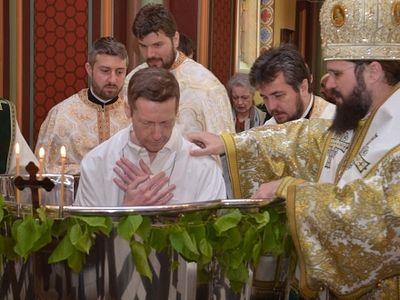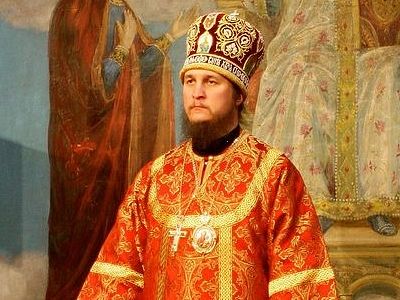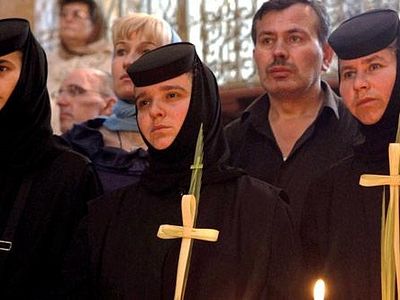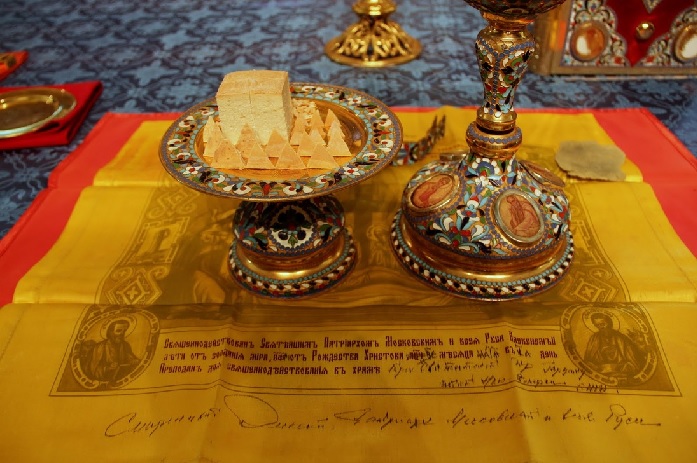
Imagine there’s no countries
It isn't hard to do
Nothing to kill or die for
And no religion too
~ John Lennon
John Lennon’s lyrics strike a chord in us. We all remember a time when we yearned for a unity with others where the slightest separation is melted away in the face of pure love and abiding peace. Indeed the longing for true communion is the fundamental God-implanted hunger in every human soul.
However over the centuries many have misused or misapplied this natural yearning for communion by artificially discounting the true borders of personhood. Examples include political ideologies such as Communism and like-minded social experiments such as hippie commune-ism. Platonism and other philosophical forms of dualism sought the release of the “invisible and indefinable” spirit from the confines of “evil” material existence. Examples of religious and deistic forms of a boundary-less union are the pantheism of Hinduism and the Christian heresy of Docetism, which claimed that Jesus only appeared to be circumscribed by a physical body.
All of these have one thing in common—they seek to create a perceived communion by breaking down extant distinctions and definitions. As the former Beatle seems to advocate, division and disunity are actually caused by boundaries and beliefs. Yet a “communion” without borders is short-lived and futile because it is not consonant with reality itself. For instance, a country is not threatened by the existence of its borders; its borders are what make possible a real identity and a unifying culture. Imagine a country without borders and I will show you an imaginary country.
Certainly, there are always dangers of unhealthy ethnocentrism, blind patriotism, or insular closed-mindedness. But a country without borders, without a distinctive history, without unifying cultural principles and symbols, without flag or anthem, is no country at all. If, because there are no borders, everyone is automatically a member, then no one is truly a member, for membership in such a non-entity is entirely meaningless.
A house without foundation and walls is not a house but merely a continuum of space indistinguishable from other space. The same applies to personal relationships. I am capable of having union with my wife because I know where she begins and where she ends, both in body and soul. I am also capable of infidelity because the borders of the marital relationship are clear. A trespassing of these organic and necessary borders will at the very least greatly harm this communion.
All of this also applies to the incarnate Christ and His Church, i.e. His incarnate Body. For the real, incarnate Christ comes to us, not as a warm and fuzzy “idea” bereft of borders, but circumscribed by a very real historical human Body, locatable, tangible, and verifiable in time and space, crucified “under Pontius Pilate.”
This same incarnate Christ founded a Church which is identified exactly with His circumscribed Body: the flesh He received exclusively from the Virgin Mary by the Holy Spirit, the flesh with which He walked the streets of the Middle East, the flesh buried and risen, the same flesh with which He ascended to God the Father and which He still bears and will bear eternally.
It is this Christ whose prayer to His Father expresses the divine desire that they may be one—not partially, nor merely in the “basics,” nor as an abstraction, nor in imagination – but just as We are one (Jn. 17:22).
It is within this context (and Orthodox Christians believe only within this context) that we can begin a discussion regarding so-called closed communion. The case for closed communion is based not on a negative premise to promote exclusivity but on a positive one that propels and preserves, among other things, the catholicity of the Church (the Greek word katholikos primarily means fullness, not merely geographical universality). It was practiced uniformly and without controversy from the apostolic period until very recent times and mirrors God’s previous work among His people in the Old Testament. It is founded upon the received tradition that has always formed and informed the Christian understanding of “Church.”
Let me say from the beginning that I acknowledge the sensitive nature of this topic and the strong feelings it can evoke. In no way have I set out to cause offense or to rub salt in any open wounds. Discussions of such central issues as Eucharistic communion should never be decided by emotions, but with a robust and courageous desire for truth and a willingness to bow before what St. Vincent of Lerins called, “what has been believed everywhere, at all times, and by all.”
Defining the Terms
Before moving on to more substantial matters, perhaps a word should be said regarding terminology, for words are no small matter. The early Christian declaration, lex orandi lex credendi (the rule of prayer is the rule of belief), reminds us how our use of words influence our beliefs and vice versa.
The difference between truth and heresy can literally turn on a word, or part of a word, as was the case in the Arian controversy and the word homoousios (“of the same essence”). As our only means to convey reality, words (most especially theological words) are worth fighting for. As G. K. Chesterton so aptly put it:
What is the good of words if they aren't important enough to quarrel over? Why do we choose one word more than another if there isn't any difference between them? If you called a woman a chimpanzee instead of an angel, wouldn't there be a quarrel about a word? If you're not going to argue about words, what are you going to argue about? Are you going to convey your meaning to me by moving your ears? The Church and the heresies always used to fight about words, because they are the only thing worth fighting about.
Now I don’t know who first coined the phrase “closed communion,” but I am certain it was not one of the Church Fathers. It is likely quite modern. This in itself might be enough to give me pause in using it. But it seems also to contain an inherent bias and implicit agenda much like other recent secular creations invented to put a positive spin on an old sin, e.g. “pro-choice,” “marriage equality” (who in their right mind could be against choice or equality?!).
Especially in America today, the word “closed” carries negative connotations. One of the worst accusations possible is that of “closed -mindedness.” A politically correct culture will not tolerate anyone or anything that is closed, for to be so is de facto “bigoted” and “intolerant.”
Therefore closed communion—referring to the long-standing tradition of communing only those who are members of a unified body—is becoming an ecclesial “sin.” Ironically, most of us would admit that a healthy society is built upon “closed” marriage.
The point here is that the expression “closed communion” is not an adequate or faithful description of the ecclesiology that undergirds the traditional practice of communion. For in reality there is no such thing as “open” or “closed” communion—there is either communion or there is not. In other words, either there exists a communion of faith expressed in a common understanding of doctrine and worship, sacramental and spiritual practice, or such communion does not exist.
The criteria for a communion of faith here is no different from the boundaries that existed in the first Christian congregation: And they continued steadfastly in the apostles’ doctrine and fellowship (literally: communion), in the breaking of the bread, and in the prayers.[1]
A more precise description of what has been practiced for most of Christian history would be called “monogamous communion.” This phrase indicates fidelity and commitment to a tangible, historical tradition and to a body of membership that likewise has committed themselves to the same. It is more faithful to the organic biblical terminology identifying the Church as Christ’s own Body (1 Cor. 12:27), His Bride (Rev. 21:9), the Israel of God (Gal. 6:16), God’s field and building (1 Cor. 3:9), and the Vine to which individual members are then grafted in (Rom. 11:17).
As we shall see, “monogamous communion”—the practice of maintaining fidelity to a body of belief as confessed, lived, and embodied tangibly in continuity with and within an identifiable community of believers—is the historical practice of the Church. It has been so, not merely as one option among many, but as the very expression of earliest understanding of ecclesiology.
Some Historical Perspective
It was not until the beginning of the twentieth century that open communion became anything more than highly unusual. Anglicans and Episcopalians, Lutherans, Baptists, Reformed Presbyterians, and Methodists all practiced closed communion at least until that time.[2] That means for close to 1,900 years the sharing of communion between Christians of differing faith was quite exceptional.[3]
Of course both the Orthodox and Catholic restrict the serving of communion to sacramental members of their respective churches. Protestant denominations also followed the long-standing tradition of the ancient Church. Methodists, for instance, were required to renew a “note of admission” to communion quarterly. Among Presbyterians, certificates of good standing were issued to those who, after being examined, were approved.
This normative approach to communal unity was carried on from the founders of the Protestant Reformation, particularly Luther and Calvin. The latter wrote passionately defending the practice of a rigorous examination of beliefs prior to admission to communion.
For everyone to be admitted to the Lord’s Supper, without distinction or selection, is a sign of contempt that the Lord cannot endure. The Lord himself distributed the supper to his disciples only … No one should be distressed when his Christianity is examined even down to the finest point when he is to be admitted to the Lord’s Supper. It should be established as part of the total state and system of discipline that ought to flourish in the church that those who are judged unworthy should not be admitted.[4]
In addition to concerns for proper instruction and preparation, Luther could not and would not tolerate divergent views of the Eucharist itself among communicants.
It terrifies me to hear that in one and the same church or at one and the same altar both parties are to find and to receive one and the same Sacrament and one party is to believe that it receives nothing but bread and wine, while the other is to believe that it receives the true body and blood of Christ. And I often wonder whether it is credible that a preacher or shepherd of souls can be so hardened and malicious as to say nothing about this and let both parties go on in this way, receiving one and the same Sacrament, everyone according to his own faith, etc. If such a person exists, he must have a heart harder than any stone, steel, or adamant. He must, in fact, be an apostle of wrath. Whoever, therefore, has such preachers or suspects them to be such, let him be warned against them as against the devil incarnate himself.[5]
It should be clear from the above that, according to Martin Luther’s own criteria for shared communion, modern day Evangelicals would be prohibited from receiving communion in the Catholic and Orthodox communions.
Even in the first millennium of Christian history, when we see one, tangible, worldwide Christendom, the idea of “open communion” with Christians of divergent views was inconceivable. In the case of heresy, whether Iconoclasm, Monotheletism, Nestorianism, Arianism, Montanism, Gnosticism—all of whom sincerely confessed Jesus Christ as Lord and took the name “Christian”—neither orthodox nor heretic shared the chalice with the other.
Remarkably, this was also true in the event of a “pure” schism, as with the Donatists in North Africa (4th-5th c.) and the Novatianists in Rome (AD 251). In each instance these Christians separated from the larger Church in protest for what they saw as disciplinary laxity. While both groups confessed and practiced an identical faith, liturgical and sacramental practice with that of the whole Church, shared communion was never admissible since community was severed.
In the early second century, the words of Ignatius of Antioch echo those of the apostle Paul (Tit. 3:10) regarding those who hold heretical views. His teaching is particularly pertinent since it relates directly to the nature of the Eucharist itself. Speaking about why these heretical Christians had subordinated the importance and frequency of their own church gatherings, he explains:
“They abstain from Eucharist and [the normative liturgical] prayer because they do not acknowledge that the Eucharist is the flesh of our Savior Jesus Christ which suffered for our sins … It is fitting to keep away from such men.”
We find this understanding in Ignatius and all the early Church Fathers, not in order to promote division, but precisely to promote and preserve a real, substantial, and complete unity. Since the Eucharist reflects the unity that God shares with His Son and Spirit, it is incomprehensible to have union with believers of discordant mind and doctrine. So Ignatius insists that his hearers remain “in one faith and in Jesus Christ” with “the bishop and the presbytery … breaking one loaf, which is the medicine of immortality, the antidote which results not in dying but in living forever in Jesus Christ.”[6]
This leads us to the meaning of communion itself.
What Do We Mean By Communion?
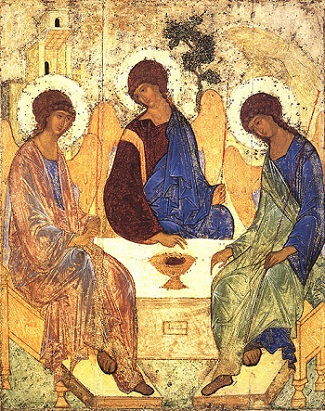
The model for the meaning of communion and Christian unity has always been God Himself, the Holy Trinity. While the Father, Son, and Holy Spirit are distinct and unique Persons, they are one; not mathematically, but in a communion of persons. The three divine Persons of the Trinity exist together in a perfect communion of love and truth expressed by their common will, energy, and activity.
Through the work of Christ, God restores the potential for the life of communion for which He created man, even taking our humanity into the very bosom of the Holy Trinity in Christ’s ascension. By taking upon Himself a Body, Jesus Christ, one of the Holy Trinity, makes possible the return to this life of communion by being brought into communion with His Body, the Church.
The Church: Communal Life
Through this biblical and patristic perspective we see that communion is not one aspect of the life of the Church, it is the life of the Church. The Church is communion. We see this vividly in the scriptural account of the first church community, for all who believed were together, and had all things in common (Acts 2:44).
Communion is a packaged deal. It does not happen without reference to the tangible life of the community. It is not an isolated moment where I “take” communion on my own terms, without reference to the community, its corporate faith and life, its tradition. Such a communion never existed in the historical Church.
And this is where the understanding and practice of “open communion” is in direct opposition to the normative Christian understanding: Holy Communion is not just an act of uniting oneself to Jesus Christ, if by that we mean an isolated Person. As Augustine reminds us, since the incarnation and resurrection, Christ is never alone. The “whole Christ,” as he puts it, is Christ with His Body.
Therefore Communion is not only a matter between the Lord and me, it is an act of communion with Christ in community. When I receive Holy Communion I also unite myself with a body of believers and with their doctrinal teaching, worship, life of discipline, and leadership.[7] In partaking of Holy Communion we give ourselves in marriage to a particular body, a specific faith community with a real history and tradition, embodying a real set of beliefs and practices that express those beliefs. We also unite ourselves to all the true members of that particular communion, past, present, and future. Put simply, we become a “member” of that church.
Communion is not only a vertical act of union, i.e. with Christ; it is also horizontal, it unites us with those gathered together as church. Holy Communion is not a “generic” sacrament, disconnected from its ecclesial context. It is the sacrament of a specific and concrete community, united by a specific polity, theology, morality, worship, and spirituality.
According to the historic Christian teaching reflected in the early Church Fathers, admittance to Holy Communion means embracing the entire faith tradition of the body. Before Holy Communion can be received, communion must already be achieved.
In the patristic understanding then, to receive communion in a Lutheran church implies you have become a member of the Lutheran communion. To receive in a Presbyterian church is to profess union with the Reformed tradition. To receive communion in a Mormon church is to join oneself to Mormon doctrine and tradition and to place oneself in communion with all Mormons throughout the world. Whether we mean to do this or not is not the point.
Despite the good intentions of John Lennon, there is no imaginary world or church without borders or beliefs. These borders and beliefs matter, especially to human persons who also have borders and freedom to choose their beliefs. These borders and beliefs have consequences. They may bring us into union with God or they may not. In the end this is a blessing because it forces us to make important decisions as to who and what we are really in communion with.
The Old Covenant was no different in this respect. When you joined Israel you joined the whole Israel—the creed, the worship, the rituals, the community, the religious culture, the whole way of life. You did not have the luxury of adopting the tradition of celebrating the Passover but passing over the Feast of Booths, or making sacrifices of thanksgiving but none for sin.
And so the apostle Paul uses organic language when he speaks about the gentiles coming into the communion of the Church, the Israel of God (Gal. 6:16). He says they were grafted in to the olive tree (Rom. 11:17), the Church. Just as were the Jewish converts described in Acts 2, those gentiles who confessed Jesus as the Messiah were grafted into the specific tradition of the apostles, into their fellowship (communion), into their pattern of sound words, (2 Tim. 1:13), into their life of communal worship, their church order, and way of life.
Church Tradition: The Boundary of Communion
To be in communion with any particular church body is to adopt their church tradition.[8] Though hard to accept for some, according to the Scriptures church tradition is the unifying bond of Christian fellowship. It is the name we give to that body of doctrine, moral teaching, worship, and church polity inherited by a group of believers. In one of his earliest letters the apostle Paul attests to this: Therefore, brethren, stand fast and hold the traditions which you were taught, whether by word or our epistle (2 Thess. 2:15). And he praises the Corinthians who keep the traditions just as I delivered them to you (1 Cor. 11:2).
The tradition is more than a set of intellectual beliefs. It encompasses a way of life, sets a boundary for what is necessary and true, and either unites or disengages one from communion with others: But we command you, brethren, in the name of our Lord Jesus Christ, that you withdraw from every brother who walks disorderly and not according to the tradition which he received from us (2 Thess. 3:6).
Like the Church itself, Church tradition is not invisible or secret. It is something that is lived and has been lived by those who came before. As Paul writes to the Hebrews: Remember your leaders, those who spoke to you the word of God; consider the outcome of their life, and imitate their faith (Heb. 13:7, RSV). The faith and tradition of any church group can be seen and experienced by observing its corporate life. As St. Irenaeus, bishop of Lyons testifies:
“It is within the power of all, therefore, in every church, who may wish to see the truth, to contemplate clearly the tradition of the apostles manifested throughout the whole world.”[9]
What has been passed down and preserved within a church body, i.e. its faith tradition, is what makes it either possible or impossible for us to unite ourselves to that body. If we are not in communion with that tradition, we cannot in clear conscience have Eucharistic communion. If we whole-heartedly accept that tradition, we should be brought into communion with that church and receive Holy Communion monogamously there.
Communal Considerations
All of this is to convey that the practice of “closed” communion is not personal or vindictive. Christians of other confessions are not excluded from Holy Communion based on a judgment of their personal faith, sincerity, or sanctity. Rather they hold to a different Christian tradition and are united to a different Christian body.
According to historical Christianity, the bishop is the guardian and embodiment of the tradition. Following this understanding, the simple litmus test for determining whether one can receive the Eucharist of any particular community is this: “Is my bishop in communion with the bishop of this local church?” If he is, you are also in communion with this church.
It is also worthy of note that churches that maintain the historical practice of monogamous communion, particularly the Orthodox Church, require from church members a good bit of preparation before receiving Holy Communion. This includes a recent confession of sin, fasting from all food and drink, prayers of preparation, reconciliation with those we have offended, etc.
These requirements are not some legalistic yoke with which to burden people, but a guard against casual and negligent reception, or worse, receiving in a state of sin without repentance. The apostle Paul warns that he who does so eats and drinks judgment to himself, not discerning the Lord’s body. For this reason many are weak and sick among you, and many sleep (1 Cor. 11:29-30). If we take the Scriptures seriously we can see that not only is “closed communion” prudent, it is a merciful and potentially lifesaving practice!
Conclusion
The Christian Church, like Her Lord, is not an imaginary and invisible abstraction. The tradition of any church is concrete and visible, expressed throughout history by real people in a tangible continuum of faith and practice (whether for 2,000 years or two years). Like the Holy Trinity, the Church is a community, a real communion expressed and embodied by a shared faith and way of life. The maintenance of real communion necessitates borders and boundaries, both doctrinal and disciplinary. If a church is to be faithful to its own tradition, the door will be opened to some things and closed to others.
Those who characterize the traditional practice as “closed communion” may forget that a church’s communion of faith, and by extension its sacrament, is actually open to all who formally embrace it and unite themselves to it. This is certainly true of the Orthodox Church. It is “closed” only in the way a marriage or a family is closed. While love and hospitality is extended, there are reasonable limits to that hospitality, without which there is no real marriage or family.
A door that is always open is not a door any more. A marriage that is open is not a marriage any more. It is for good reasons that doors swing open and closed. The principles of integrity and monogamy depend upon it.
Few of us would walk into a stranger’s house, head for the refrigerator and help ourselves to a midday snack. Still fewer would demand to be served that snack by the head of the household. The practice and expectation of “open communion” is a very modern phenomenon without precedence throughout most of Church history. It is founded upon a new ecclesiology unknown to the great Fathers and Saints of the Church. It reflects a loss of the mindset that faithfully preserved the Christian tradition that many of us cherish. And it places us in danger; danger of an imaginary church, an imaginary faith, and an imaginary Christ that will someday disappear from our imaginations altogether.
It is tragic that Christendom is rife with real divisions. Yet by denying this reality we deny ourselves the opportunity and the possibility of the pursuit of truth and conviction. We become the man who never actually buys the cow because he gets the milk for free.
Holy Communion has never been free. The Eucharist, and real communion, comes with the price of monogamy, of standing for and within a tangible faith community and tradition.
In Mere Christianity, which C. S. Lewis wrote only to bring skeptics and seekers to the doorstep of Christian faith, he leaves the reader standing in the hall “out of which doors open into several rooms.” In his analogy the “rooms” are the existing church communions. He makes it clear to the reader that he must eventually choose a room, for the hall (a belief in the basic Christian principles) is not “an alternative to the creeds of the existing communions.”[10] Lewis’ point is that Christians are in the business of monogamy. There is no generic “Christianity,” there never has been. There is only the practice of Christianity with a church body. And there is no church communion called “Mere Christianity.” There are church bodies with real histories, real dogmas (whether consciously recognized or not), and real tradition. As Lewis conveys, we cannot “play church” in the hallway imagining we are really in one of the rooms.
We must seek, ask, knock, and prayerfully make a choice of what tradition we can marry in good faith. And our decision must be made on conviction of truth and authenticity, not on convenience, emotion, or even personal tastes. As Lewis put it: “you must be asking which door is the true one; not which pleases you best by its paint and paneling.”[11] Without this, my communion is ultimately with “me, myself, and I,” not with the historical Christ, the apostles, and saints.

